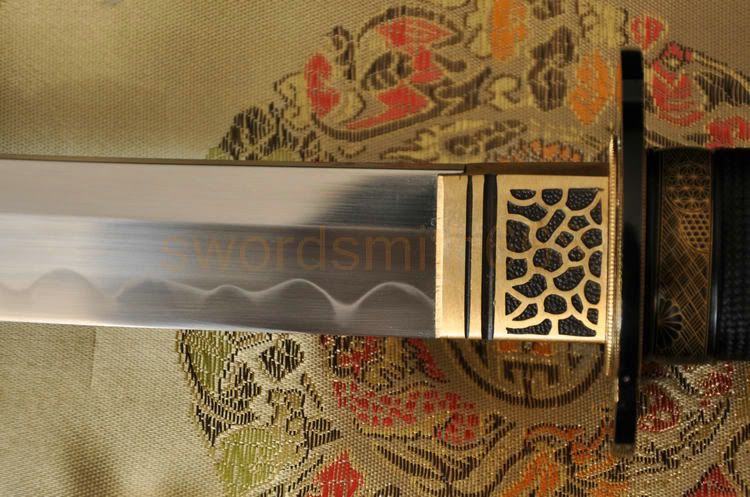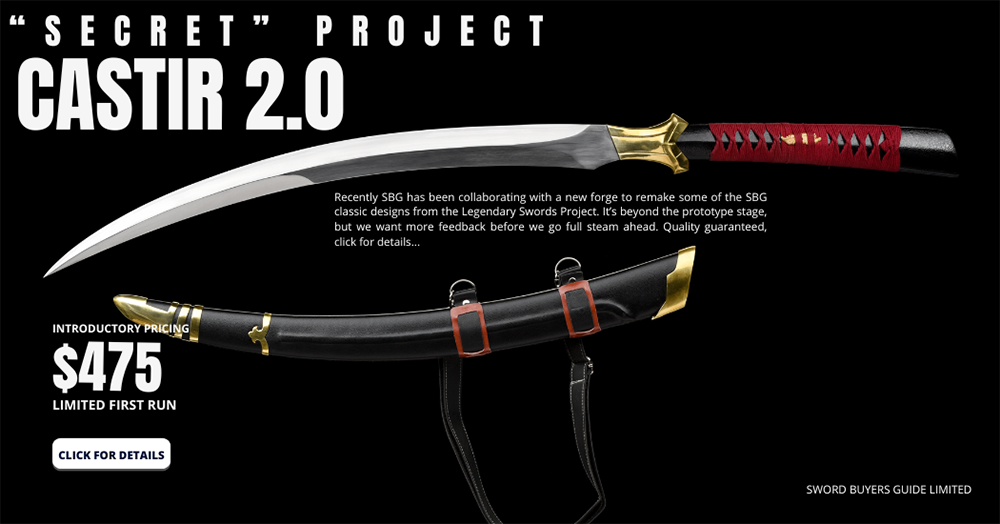|
|
Post by romeo on Aug 10, 2015 16:35:18 GMT
Hello!
I'm very excited to say that I'm a couple days away from ordering my first katana! The katana that I will be ordering is customizable, so I've been given a choice between 2 types of steel. The first that is offered is a blade made of 1060 high carbon steel, tempered and oil quenched. The second is 1095 high carbon steel, clay tempered and folded. I was wondering if anyone could answer the following :
I. Which one is more durable?
II. Which one is the most forgiving for a bad cut during a training session?
III. Advantages and disadvantages of both of the steels.
IV. How often should I oil my katana?
V. Which one would you ultimately choose?
I'll be using this katana for martial arts purposes, so I don't want something that will just end up being a wall hanger. The sale price of the katana is approx 200$ CAD (that includes shipping) and is coming from China. I would like to post the company name, but I'm not quite sure if I'm allowed to do that. However, I've been reading many good reviews about said company.
I have trust in your experience and I thank you very much for the advice!
|
|
Mikeeman
Member
Small Business Operator
Posts: 2,904 
|
Post by Mikeeman on Aug 10, 2015 16:43:57 GMT
What I CAN say is that oil quenching 1060 will probably not make it hard enough. It will bend easily and not keep an edge. Unless, of course, you mean 9260. Then an oil quench is good. There is only one company you are not allowed to mention around here, and I don't think that's the one you're talking about.  |
|
|
|
Post by romeo on Aug 10, 2015 16:47:27 GMT
Thanks Mikeeman!
Okay, the company name is Hanbon Swords/Hanbon Forge. I've heard and read a lot of good reviews on them. Would you know any more information?
|
|
|
|
Post by Lukas MG (chenessfan) on Aug 10, 2015 16:53:20 GMT
What I CAN say is that oil quenching 1060 will probably not make it hard enough. It will bend easily and not keep an edge. Unless, of course, you mean 9260. Then an oil quench is good. That's just not true. 1060 is an oil quencher and I have made blades out of it that came out perfectly hard with a regular oil quench. Really, practically all modern steel do well in an oil quench, you VERY rarely have to resort to water. |
|
|
|
Post by L Driggers (fallen) on Aug 10, 2015 17:06:32 GMT
1060 can be tempered to a spring temper. They were making car springs out of 1060 and 1075 before 5160 or 9260 can out. Cold Steel uses 1055 for their swords they flex well (Yes I know Cold Steel doesn't make their own swords). Wouldn't call 1060 a modern steel it been around a long time.
|
|
|
|
Post by KaOsBlaKbLaDe on Aug 10, 2015 18:38:49 GMT
Isn't 1095 basically the same as t-10?
|
|
Mikeeman
Member
Small Business Operator
Posts: 2,904 
|
Post by Mikeeman on Aug 10, 2015 19:25:27 GMT
What I CAN say is that oil quenching 1060 will probably not make it hard enough. It will bend easily and not keep an edge. Unless, of course, you mean 9260. Then an oil quench is good. That's just not true. 1060 is an oil quencher and I have made blades out of it that came out perfectly hard with a regular oil quench. Really, practically all modern steel do well in an oil quench, you VERY rarely have to resort to water. Here's my theory as to why that is. You typically make euro style swords. The one's I've seen and handled (which is very few, admittedly) have been wider and thinner blades. If it has the same mass as a katana, it would cool quicker in the same quenchant due to a larger surface area to contact the quenchant. I know most euro swords are oil quenched, and I think that's why. Since it's wider, thinner, and cools faster, it makes sense to quench them in oil. Katanas, however, are thicker. And have more "core steel" so to speak. So if you quenched them in oil, they would cool too slow because not as much surface area is contacting the quenchant. So a water quench makes more sense in this case. That's just my theory. Take it for what it is. To Romeo: I don't typically like eBay vendors. That's just my opinion, and you can do what you want with that, but I find that your quality level goes down with the "build it yourself" eBay sellers. If I were you, I'd try to get a mono 1095. If that's not an option, the folded 1095 would be preferable since it's a higher carbon content, and almost guaranteed to be water quenched to make the hamon. It may take a set on a bad cut, but so will a soft 1060 blade. At least the 1095/whatever else they folded it with would hold an edge. To Kaosblade: 1095 is NOT like T10. However, what the Chinese forges typically call T10 is closer to American 1095. If I'm not mistaken, true T10 is a tungsten alloy. Chinese T10 doesn't have any Tungsten. You might check in with Aussie Rabbit on that one. He knows more about it. |
|
|
|
Post by Giantsquid23 on Aug 10, 2015 20:06:59 GMT
I have a katana and wakizashi from Hanbon swords. They are both made of 1095 steel, clay tempered, and unfolded. They both handle very well and are reasonably forgiving. My advice would be to ask Hanbon to put a full samegawa wrap on the tsuka, as they make the tsuka much thinner and better formed, and to get a hinerimaki wrap.
|
|
|
|
Post by romeo on Aug 10, 2015 22:40:08 GMT
Thanks everyone for all of the useful information!
To Mikeeyman :
Is there a reason that you suggested mono tempered 1095 over folded steel? I thought that folded steel was how katanas were supposed to be made, according to my Sensei.
To Giantsquid23 :
Thank you so much for the info! I will be sure to do that.
|
|
Mikeeman
Member
Small Business Operator
Posts: 2,904 
|
Post by Mikeeman on Aug 10, 2015 22:52:45 GMT
In the "days of old" yes, folded was beneficial. Carbon content could vary wildly from chunk to chunk of the steel that came out of the giant furnace. To counter this, they would smoosh all the chunks together in to one bar, and fold it, like, a bazillion times (usually just a few, actually) until the layers of varying carbon content were so fine that the it was almost an even amount in all places.
Today's steel has much more even carbon content and folding isn't needed. It does, however, look nice. I have a Chinese folded sword and am quite fond of it. Folded swords aren't inherently WORSE than their non folded counterparts, but there's just more room for mistakes. Plus, if it's folded, that means it folded with something with lower carbon content. So it would be 1095 and probably something like 1060 folded together. So the edge on your sword has a 50/50 chance of being 1095 instead of 1060. The 1060 won't hold an edge as well as 1095. Will you notice the difference? Probably not. I'm just throwing it out there.
|
|
|
|
Post by Timo Nieminen on Aug 10, 2015 23:32:46 GMT
Wasn't folded just to homogenise it, but also to get rid of the slag. Tamahagane, like any other bloomery steel/iron, was produced without the iron melting (the ore is reduced to metallic iron in the solid state), so it's got lots of slag (the silicates and carbonates etc. from the rest of the stuff in the ore).
|
|
|
|
Post by Lukas MG (chenessfan) on Aug 11, 2015 7:16:40 GMT
That's just not true. 1060 is an oil quencher and I have made blades out of it that came out perfectly hard with a regular oil quench. Really, practically all modern steel do well in an oil quench, you VERY rarely have to resort to water. Here's my theory as to why that is. You typically make euro style swords. The one's I've seen and handled (which is very few, admittedly) have been wider and thinner blades. If it has the same mass as a katana, it would cool quicker in the same quenchant due to a larger surface area to contact the quenchant. I know most euro swords are oil quenched, and I think that's why. Since it's wider, thinner, and cools faster, it makes sense to quench them in oil. Katanas, however, are thicker. And have more "core steel" so to speak. So if you quenched them in oil, they would cool too slow because not as much surface area is contacting the quenchant. So a water quench makes more sense in this case. That's just my theory. Take it for what it is. I doubt it. 1060 might need a water quench to fully harden when you're playing with big cubes or the like (industrial stuff) but for blades, oil should be the way to go. Katana blades aren't THAT much more massive than euros... there is a large variety with euro blades and there absolutely are some that are 8mm-10mm thick at the base with a strong mid rib, so quite a lot of material. I haven't made such a blade out of 1060 (only 9260) but I still think a regular oil quench would be sufficient there. However, this is just me thinking, no proof to back it up. |
|
|
|
Post by romeo on Aug 11, 2015 22:03:50 GMT
Thanks again everyone!
Alright, so right now my main concern is the brittleness of the sword. I understand that the harder the sword is, the more brittle it is. How brittle are we talking for a 1095 folded steel blade and a 1095 mono tempered blade?
|
|
Mikeeman
Member
Small Business Operator
Posts: 2,904 
|
Post by Mikeeman on Aug 11, 2015 22:07:40 GMT
It's highly unlikely that you will break an eBay 1095 sword. They are usually softer than their name brand counterparts. Unless you really, really try, I doubt you can screw it up that bad.
|
|
|
|
Post by romeo on Aug 12, 2015 4:06:55 GMT
I bought the katana! Thanks everyone!!
|
|
|
|
Post by aussie-rabbit on Aug 12, 2015 4:07:02 GMT
Thanks Mikeeman! Okay, the company name is Hanbon Swords/Hanbon Forge. I've heard and read a lot of good reviews on them. Would you know any more information? I have a couple of Hanbons as keepers (two folded and one mono) along with some I have bought for others, all have been excellent for the price, if you have a choice for either then choose the 1095 folded, they tend to be a tad sharper while still being forgiving, also have a nice if somewhat plain hamon - you can ask for a plain habaki (many of us think the patterned one looks silly) if you wish also. Yao, the manager/owner is helpful and is fiercely proud of his 100% rating.  |
|
|
|
Post by aussie-rabbit on Aug 12, 2015 4:15:09 GMT
To Kaosblade: 1095 is NOT like T10. However, what the Chinese forges typically call T10 is closer to American 1095. If I'm not mistaken, true T10 is a tungsten alloy. Chinese T10 doesn't have any Tungsten. You might check in with Aussie Rabbit on that one. He knows more about it. Mikeeman is correct, the difference between Chinese T10 and 1095 is almost nothing, more hype than reality, the better forges such as Huawei may have a slightly higher carbon content in their T10, remembering the steel comes from the same series of mills, one steel mill's T10 is another's 1095 and vice versa  |
|
|
|
Post by DigsFossils-n-Knives on Aug 12, 2015 13:50:44 GMT
That's just not true. 1060 is an oil quencher and I have made blades out of it that came out perfectly hard with a regular oil quench. Really, practically all modern steel do well in an oil quench, you VERY rarely have to resort to water. Here's my theory as to why that is. You typically make euro style swords. The one's I've seen and handled (which is very few, admittedly) have been wider and thinner blades. If it has the same mass as a katana, it would cool quicker in the same quenchant due to a larger surface area to contact the quenchant. I know most euro swords are oil quenched, and I think that's why. Since it's wider, thinner, and cools faster, it makes sense to quench them in oil. Katanas, however, are thicker. And have more "core steel" so to speak. So if you quenched them in oil, they would cool too slow because not as much surface area is contacting the quenchant. So a water quench makes more sense in this case. That's just my theory. Take it for what it is. ... 1060, 1075, 1095 blades can be either quenched in water, brine, or oil. Remember that historical Euro(perhaps?) or Japaneses (definitely) were quenched in water. BUT, there is a higher probability of cracks or breaks when using brine or water. Oil is safer for the blade. From my research on the internet I see that folks are posting that 1 in 4 blades (or worse) can break when quenched in water. Why use water or brine? Better activity in the hamon. In fact it's better to use a low viscosity "fast" oil to get a nice hamon activity than your veggie or motor oil. And again, water makes for the most activity in the hamon. (I have no first hand experience. This is all from recent internet research.) W.r.t. the theory of "core steel" and cooling speed, I'm not sure what is meant here since many times clay is applied to spine of a sword and the heat treat process is adjusted slightly to accommodate this effect. |
|
Mikeeman
Member
Small Business Operator
Posts: 2,904 
|
Post by Mikeeman on Aug 12, 2015 14:40:01 GMT
Here's my theory as to why that is. You typically make euro style swords. The one's I've seen and handled (which is very few, admittedly) have been wider and thinner blades. If it has the same mass as a katana, it would cool quicker in the same quenchant due to a larger surface area to contact the quenchant. I know most euro swords are oil quenched, and I think that's why. Since it's wider, thinner, and cools faster, it makes sense to quench them in oil. Katanas, however, are thicker. And have more "core steel" so to speak. So if you quenched them in oil, they would cool too slow because not as much surface area is contacting the quenchant. So a water quench makes more sense in this case. That's just my theory. Take it for what it is. ... 1060, 1075, 1095 blades can be either quenched in water, brine, or oil. Remember that historical Euro(perhaps?) or Japaneses (definitely) were quenched in water. BUT, there is a higher probability of cracks or breaks when using brine or water. Oil is safer for the blade. From my research on the internet I see that folks are posting that 1 in 4 blades (or worse) can break when quenched in water. Why use water or brine? Better activity in the hamon. In fact it's better to use a low viscosity "fast" oil to get a nice hamon activity than your veggie or motor oil. And again, water makes for the most activity in the hamon. (I have no first hand experience. This is all from recent internet research.) W.r.t. the theory of "core steel" and cooling speed, I'm not sure what is meant here since many times clay is applied to spine of a sword and the heat treat process is adjusted slightly to accommodate this effect. Not on through hardened swords. 1060 could handle a water quench no problem, I think. I know 1045 you can quench and not even temper. (done it) so I'd say 1060 would have a very high survival rate. Plus, since it's TH, there is less stress to actually pull the edge apart. |
|
|
|
Post by L Driggers (fallen) on Aug 12, 2015 17:48:00 GMT
1060, 1075 or 1095 can crack in a water quench even through hardened. I've crack a few axes this way and a 3 or 4 knives. Hate it when I hear the sound of a blade cracking.
|
|












